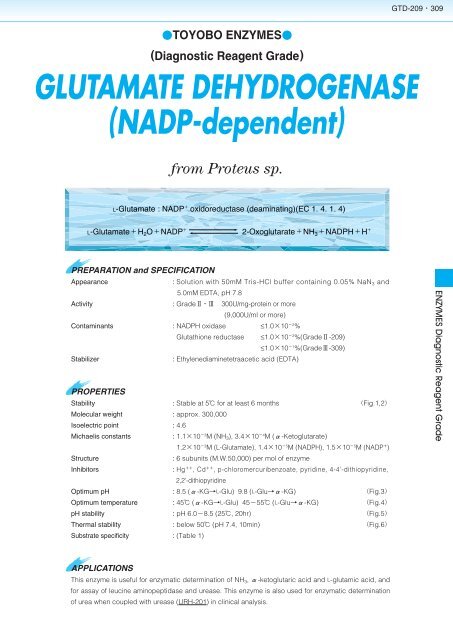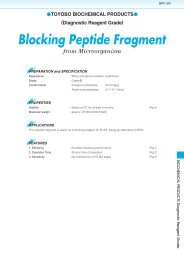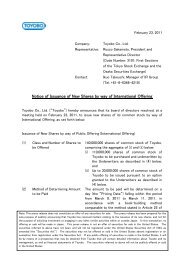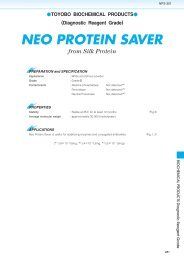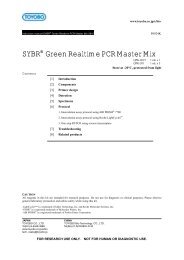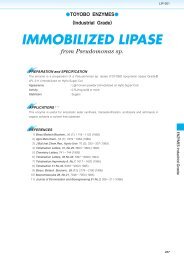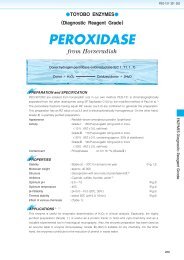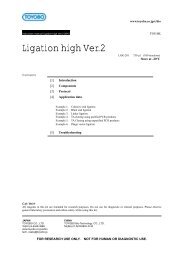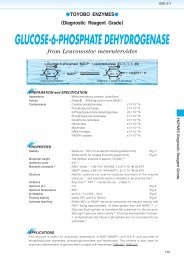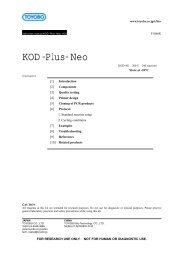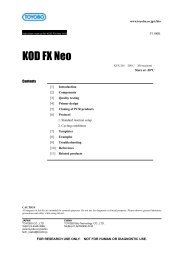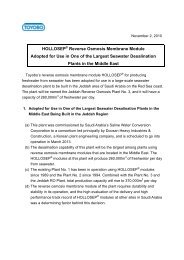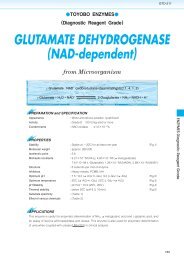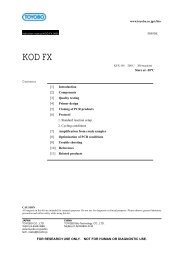GLUTAMATE DEHYDROGENASE (NADP-dependent) - Toyobo
GLUTAMATE DEHYDROGENASE (NADP-dependent) - Toyobo
GLUTAMATE DEHYDROGENASE (NADP-dependent) - Toyobo
Create successful ePaper yourself
Turn your PDF publications into a flip-book with our unique Google optimized e-Paper software.
GTD-209309<br />
TOYOBO ENZYMES<br />
(Diagnostic Reagent Grade)<br />
<strong>GLUTAMATE</strong> <strong>DEHYDROGENASE</strong><br />
(<strong>NADP</strong>-<strong>dependent</strong>)<br />
from Proteus sp.<br />
L-Glutamate : <strong>NADP</strong> oxidoreductase (deaminating)(EC 1. 4. 1. 4)<br />
L-GlutamateH 2 O<strong>NADP</strong> 2-OxoglutarateNH 3 <strong>NADP</strong>HH <br />
PREPARATION and SPECIFICATION<br />
Appearance<br />
: Solution with 50mM Tris-HCl buffer containing 0.05% NaN 3 and<br />
5.0mM EDTA, pH 7.8<br />
Activity<br />
: Grade300U/mg-protein or more<br />
(9,000U/ml or more)<br />
Contaminants : <strong>NADP</strong>H oxidase ≤1.010 2 %<br />
Glutathione reductase ≤1.010 2 %(Grade-209)<br />
≤1.010 1 %(Grade-309)<br />
Stabilizer<br />
: Ethylenediaminetetraacetic acid (EDTA)<br />
PROPERTIES<br />
Stability : Stable at 5 for at least 6 months Fig.1,2<br />
Molecular weight : approx. 300,000<br />
Isoelectric point : 4.6<br />
Michaelis constants<br />
: 1.110 3 M (NH 3 ), 3.410 4 M (-Ketoglutarate)<br />
1.210 3 M (L-Glutamate), 1.410 5 M (<strong>NADP</strong>H), 1.510 5 M (<strong>NADP</strong> )<br />
Structure<br />
: 6 subunits (M.W.50,000) per mol of enzyme<br />
Inhibitors<br />
: Hg , Cd , p-chloromercuribenzoate, pyridine, 4-4'-dithiopyridine,<br />
2,2'-dithiopyridine<br />
Optimum pH : 8.5 (-KGL-Glu) 9.8 (L-Glu-KG) Fig.3<br />
Optimum temperature : 45 (-KGL-Glu) 4555 (L-Glu-KG) Fig.4<br />
pH stability : pH 6.08.5 (25, 20hr) Fig.5<br />
Thermal stability : below 50 (pH 7.4, 10min) Fig.6<br />
Substrate specificity : (Table 1)<br />
APPLICATIONS<br />
This enzyme is useful for enzymatic determination of NH 3 , -ketoglutaric acid and L-glutamic acid, and<br />
for assay of leucine aminopeptidase and urease. This enzyme is also used for enzymatic determination<br />
of urea when coupled with urease (URH-201) in clinical analysis.
GTD-209309<br />
ASSAY<br />
Principle:<br />
-KetoglutarateNH 3 <strong>NADP</strong>HH glutamate dehydrogenase<br />
L-Glutamate<strong>NADP</strong> H 2 O<br />
The disappearance of <strong>NADP</strong>H is measured at 340nm by spectrophotometry.<br />
Unit definition:<br />
One unit causes the oxidation of one micromole of <strong>NADP</strong>H per minute under the conditions described below.<br />
Method:<br />
Reagents<br />
A. Buffer solution<br />
B. NH 4 Cl solution<br />
0.1M Tris-HCl buffer, pH 8.3<br />
3.3M<br />
C. -Ketoglutarate solution 0.225M (adjust the pH to 7.09.0 with NaOH)(Should be prepared fresh)<br />
D. <strong>NADP</strong>H solution<br />
E. Enzyme diluent<br />
7.5mM (Should be prepared fresh)<br />
50mM K-Phosphate buffer, pH 6.6 containing 0.2% BSA and 50mM EDTA<br />
Procedure<br />
1. Prepare the following reaction mixture in a cuvette (d1.0cm)<br />
and equilibrate at 30 for about 5 minutes.<br />
2.5ml Buffer solution (A)<br />
0.2ml NH 4 Cl solution (B)<br />
0.1ml -Ketoglutarate solution (C)<br />
0.1ml <strong>NADP</strong>H solution (D)<br />
Concentration in assay mixture<br />
Tris-HCl buffer<br />
-Ketoglutarate<br />
NH 4 Cl<br />
<strong>NADP</strong>H<br />
EDTA<br />
85 mM<br />
7.6 mM<br />
0.22 M<br />
0.25mM<br />
0.85mM<br />
2. Add 0.05ml of the enzyme solution and mix by gentle inversion.<br />
3. Record the decrease in optical density at 340nm against water for 2 to 3 minutes in a spectro-photometer<br />
thermostated at 30 and calculate the OD per minute from the linear portion of the curve (OD test).<br />
At the same time, measure the blank rate (OD blank) by using the same method as the test except that<br />
the enzyme diluent (E) is added instead of the enzyme solution.<br />
<br />
Dilute the enzyme preparation to 0.40.9U/ml with ice-cold enzyme diluent (E), immediately before the<br />
Calculation<br />
assay.<br />
Activity can be calculated by using the following formula<br />
OD/min (OD testOD blank)Vtdf<br />
Volume activity (U/ml) <br />
6.221.0Vs<br />
OD/min9.486df<br />
Vt<br />
Vs<br />
Total volume (2.95ml)<br />
Sample volume (0.05ml)<br />
6.22 Millimolar extinction coefficient of <strong>NADP</strong>H (F/micromole)<br />
1.0 Light path length (cm)<br />
df<br />
Dilution factor<br />
REFERENCE<br />
1) H.Shimizu, T.Kuratsu and F.Hirata; J.Ferment.Technol., 57, 428 (1979).
GTD-209309<br />
Table 1. Substrate Specificity of Glutamate dehydrogenase<br />
Substrate (50mM)<br />
Relative activity<br />
Substrate (50mM)<br />
Relative activity<br />
L-Glutamate 100 L-Glutamine 0.01<br />
L-Norvaline 0.39 L-Aspartate 0.01<br />
L--Aminobutyrate 0.19 L-Asparagine 0.01<br />
L-Norleucine 0.04 L-Valine 0.01<br />
D,L-Homocysteine 0.03 L-Leucine 0.01<br />
L-Isoleucine 0.02 L-Alanine 0.01<br />
L-Methionine 0.01<br />
Glutamate dehydrogenase:18U/ml of 0.1M glycine-NaOH buffer, pH 9.0 <strong>NADP</strong> + : 0.3mM<br />
100<br />
100<br />
100<br />
Residual Activity,%<br />
50<br />
5<br />
25<br />
45<br />
Relative Activity<br />
50<br />
Residual Activity,%<br />
50<br />
0123 4 5 8 12<br />
(weeks) Period (months)<br />
Fig.1. Stability (Solution)<br />
50% glycerol solution in 25mM Tris-HCI buffer<br />
contg. 2.5mM EDTA, pH7.8<br />
enyzme concentration: 5,000U/ml<br />
0 5 6 7 8 9 1011<br />
pH<br />
Fig.3. pH-Activity<br />
,KG L-Glu;,L-Glu-KG<br />
in 0.1M buffer solution:pH7.4-8.8,<br />
Tris-HCI;pH8.7-10.7,glycine-NaOH<br />
0 5 6 7 8 9 1011<br />
pH<br />
Fig.5. pH-Stability<br />
25, 20hr-treatment with 0.1M buffer solution:<br />
pH4.4-6.2, acetate; pH6.2-8.4, phosphate;<br />
pH8.8-10.2, glycine-NaOH<br />
100<br />
100<br />
100<br />
Residual Activity,%<br />
50<br />
5<br />
25<br />
45<br />
Relative Activity<br />
50<br />
Residual Activity,%<br />
50<br />
0123 4 5 8<br />
(weeks) Period (months)<br />
Fig.2. Stability (Suspension)<br />
3.0M ammonium sulfate suspension in 50mM<br />
Tris-HCI buffer containing 5mM EDTA. pH7.8<br />
enzyme concentration : 10,000U/ml<br />
0 20 30 40 50 60 70<br />
Temperature, <br />
Fig.4. Temperature activity<br />
,KGL-Glu: 0.1M Tris-HCI buffer,<br />
pH8.3; , L-Glu-KG:0.1M glycine-<br />
NaOH buffer,pH10.0<br />
0 20 30 40 50 60 70<br />
Temperature, <br />
Fig.6. Thermal stability<br />
10min-treatment with 0.1M K-phosphate<br />
buffer,pH7.4
GTD-209309<br />
<br />
<br />
3 <br />
glutamate dehydrogenase<br />
2 <br />
<br />
<br />
<br />
<br />
<br />
<br />
4 <br />
<br />
<br />
<br />
<br />
<br />
P<br />
<br />
<br />
<br />
<br />
P <br />
P 4 <br />
P <br />
P <br />
P<br />
<br />
<br />
<br />
<br />
<br />
<br />
<br />
<br />
P<br />
<br />
P<br />
P<br />
<br />
<br />
F


